Building resilience in petrochemicals
Navigating disruption and preparing for new opportunities
The changing petrochemicals landscape
The US petrochemical industry is transforming. The industry’s future is being shaped by shifts in end-market demand, changes in feedstock dynamics, overcapacity, and a growing push toward sustainability. Moreover, most industry leaders are concerned about the uncertainty of the current macroeconomic environment being shaped by COVID-19. Five fundamental questions could help determine the industry’s future trajectory:
Learn more
Explore the Building resilience in oil, gas, and chemicals collection
Browse the Oil, gas & chemicals collection
Learn about Deloitte’s services
Go straight to smart. Get the Deloitte Insights app
- How are the end markets changing?
- Will US companies continue to enjoy a long-term feedstock advantage?
- What will be the impact of overcapacity?
- How can companies cope with international trade barriers?
- How can the industry become more sustainable and circular?
Deloitte conducted a series of executive interviews with more than 25 senior North American petrochemical industry leaders to offer insights on significant shifts that are likely to impact petrochemical companies in the next 10 years (figure 1). Each shift varies in the time horizon of its potential impact, the scale of disruption it could deliver, and the preparedness of petrochemical companies for its expected impact.
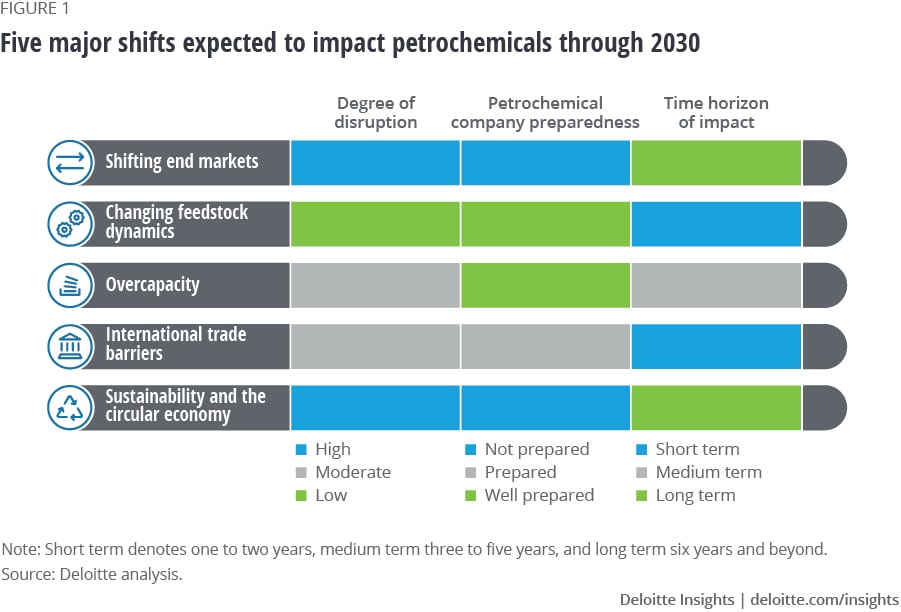
All these shifts could define how the industry could possibly look by 2030. This article examines the major shifts and recommends how petrochemical companies can navigate this changing industry landscape and prepare for new opportunities.
A period of profound transition
The US petrochemicals industry is at a crossroads as it is experiencing both cyclical and structural shifts. While the industry was already facing cyclical pressures such as overcapacity, pricing pressures, and trade uncertainty before 2020, many post–COVID-19 changes have a structural or disruptive character. Unlike the past downturns that were primarily more cyclical in nature, petrochemical companies are now experiencing significant fundamental shifts in demand, changes in how they operate, and the way they interact with and serve customers on a much larger scale. As a result of these profound changes, the industry will likely look very different in the next decade.
The industry could further consolidate, with fewer companies operating in the future. The top three petrochemical players currently account for 40% share of the industry revenue in the United States in 2020, and this proportion is expected to be more than half of the industry revenue by 2030.1 This has implications along three primary dimensions—where companies operate, how they operate, and how they serve customers.
The top three petrochemical players currently account for 40% share of the industry revenue in the United States in 2020, and this proportion is expected to be more than half of the industry revenue by 2030.
Where companies operate: As base chemicals capacity continues to shift to demand markets such as China and India,2 new manufacturing technologies such as crude-oil-to-chemicals (COTC) could reconfigure global supply chains for certain base chemicals, especially aromatics. To address future demand needs and mitigate supply chain shocks, companies could move to manage some of their downstream operations and production more regionally. This would redefine the global footprint for many companies as industry players would be required to open new channels and focus on strategic sourcing activities. For instance, Air Liquide has built capabilities in major international markets in an effort to strengthen its proximity to customers and markets and accelerate decision-making.3
How companies operate: Companies could be forced to change the way they operate, including operating at variable utilization rates and capacities; there will likely also be changes in how and where employees work. Many organizations have already adjusted to working remotely. For instance, Shell has restructured its infrastructure to support work-from-home capabilities for more than 70,000 employees.4 Moreover, there will be greater focus on asset reliability and performance to strengthen asset dependability using advanced digital technologies such as the Internet of things (IoT) and remote monitoring. Many companies will monitor their plants remotely using artificial intelligence (AI) to optimize individual assets and the entire value chain. Using connected technologies across their plants, petrochemical companies can connect all the information to simulate scenarios, predict outcomes, and take corrective action.
How companies serve customers: The industry will likely become more sophisticated in how it sells products and interacts with customers. Many companies will increasingly use digital tools and offer self-service capabilities as leading e-commerce platforms provide. So, business-to-business (B2B) e-commerce solutions and remote selling that limit in-person interaction could prevail. Also, customers should expect a simplified ordering process, especially in a contactless environment, and better digital experiences for buyers, such as live chat. For instance, BASF has launched two personal care and cleaning solutions microsites to provide formulation expertise to its customers online.5
In the rapidly transforming petrochemical landscape, these trending shifts can quicken the pace of disruption, making it imperative for petrochemical companies to prepare accordingly. Let’s delve further into how these five shifts could catalyze changes in the next decade.
Changing end markets
Growing need to create new applications and value streams
Petrochemical activity and production are closely tied to major end markets such as automotive and construction, where disruption is intensifying. Globalization, rapid urbanization, and increased mobility—the megatrends that drove higher GDP and consumer spending over the past two decades—are slowing. As a result, all major US petrochemical end markets are expected to contract in the near term, with some likely experiencing double-digit declines impacting production volumes (figure 2).6 Vehicle sales and housing starts are likely to recover to 2019 levels only after 2023.7 However, petrochemical production is expected to rebound by late 2021 on account of offsetting demand for plastics used in end markets such as electronics and consumer packaging.8
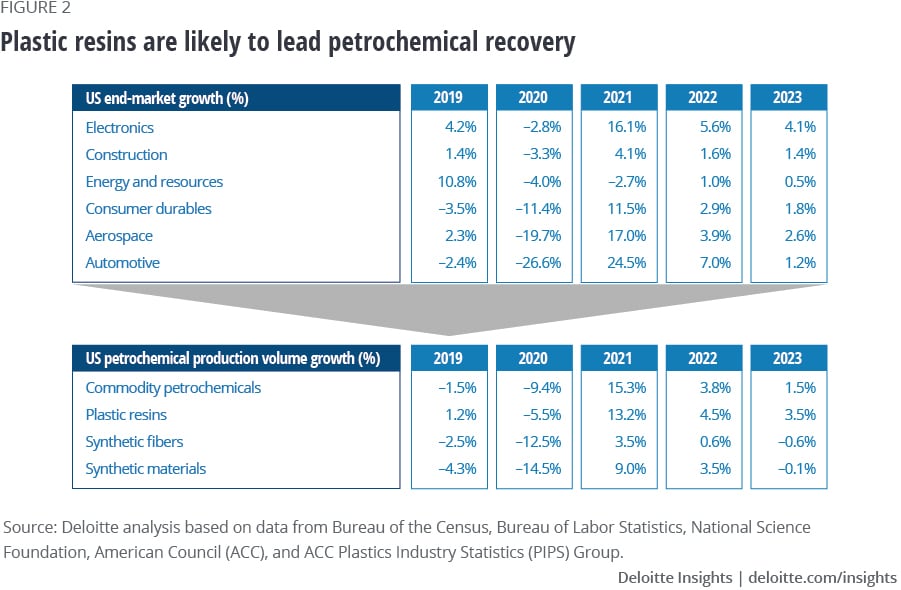
Given the headwinds, it seems to make sense for industry players to find new growth opportunities and extract more from their existing assets and resources. With changing end-market demand structure, companies could enter value streams associated with future growth markets (figure 3). They can do so by investing more in innovation—not only in new product or technology development but also in new business models. In addition, niche markets within key end-use industries might provide newer growth avenues for petrochemicals and plastics. For instance, the average plastics content in an automobile still stands below 10%,9 which offers an opportunity to incorporate more high-performance plastics and other chemicals into newer vehicle models to reduce weight and improve fuel efficiency. So, companies’ key consideration should be to shift from being primary suppliers of traditional products in existing markets to suppliers of high-end materials with long-term potential in new and growing markets.
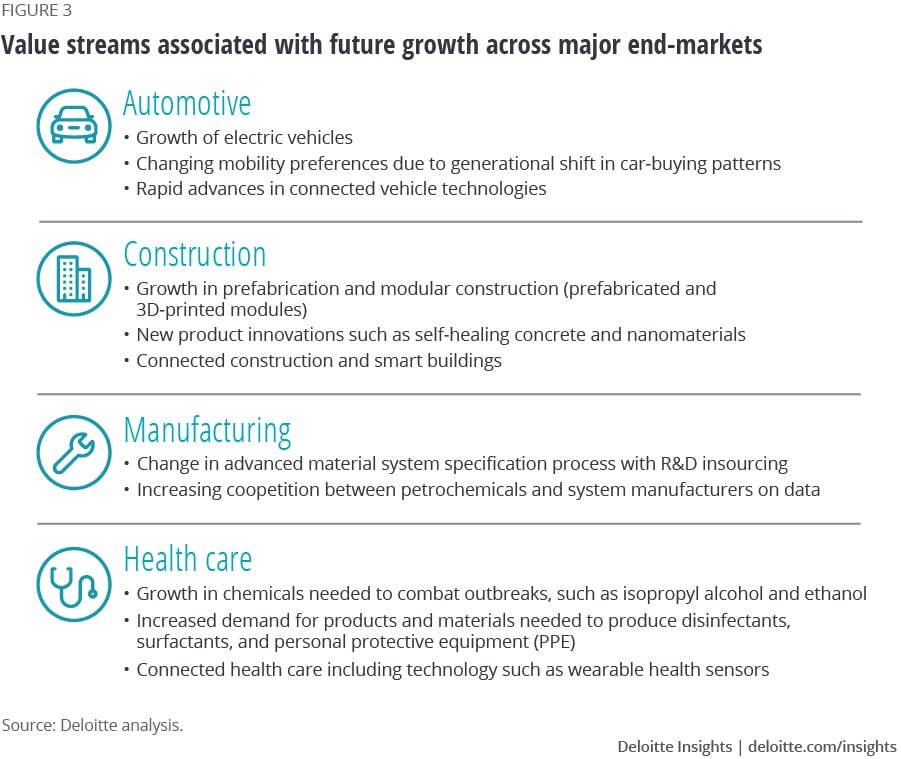
Below is a brief analysis of some key trends in two major end markets—automotive and construction—which still promise tailwinds for petrochemicals in the long term.
Automotive: Favorable policies, corporate investments, and growing environmental concerns among consumers are expected to drive US electric vehicle (EV) sales to reach 5.3 million in 2025 from 1.8 million in 2020 (figure 4).10 With the Corporate Average Fuel Economy (CAFE) standards in place, automakers will likely increase the mix of EVs in vehicle production, creating new opportunities for battery systems, but less for structural plastic. While decline in auto sales and growth in EVs can lead to lower demand for some chemical products (such as catalysts, gasoline-resistant plastics, and fuel additives) in automobiles with internal combustion engines, it opens up new segments around battery technologies and lightweight materials.

Construction: The need to reduce project costs and expedite project completion rate in construction appears to be driving new product innovation in additives and nanomaterials, including new polymer composites. Furthermore, technology advancements and innovative material design are driving demand for high-quality polyurethane (PUR) insulation products that reduce energy loss. The market for advanced construction petrochemicals in the United States could grow by about 32% by 2025 (figure 5).11
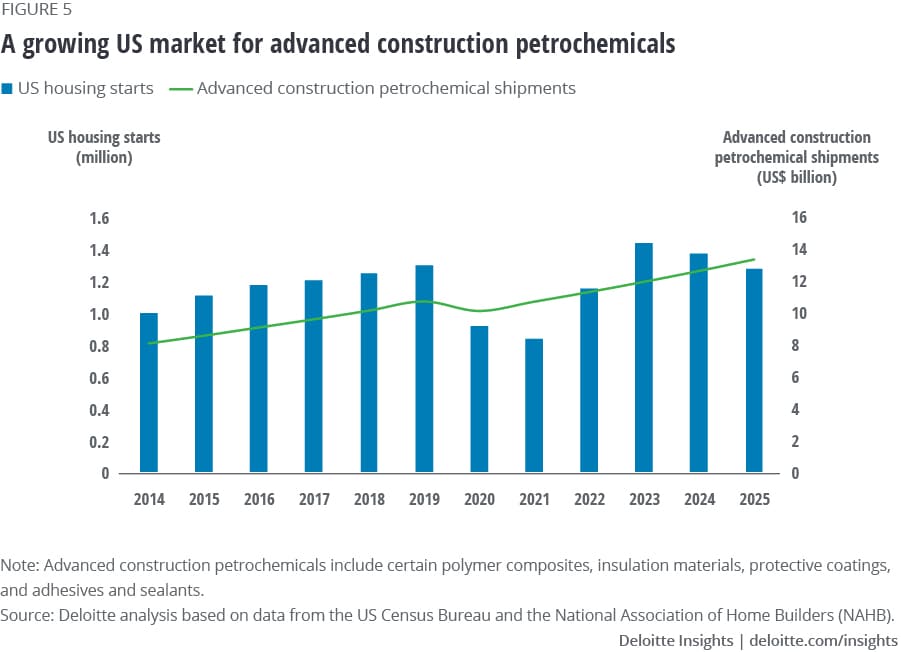
Aligning product strategy with end-market shifts could be crucial as many markets offer potential long-term growth opportunities in emerging applications (figure 6). Market-backed innovation into new materials and processes can help petrochemical companies expand to new frontiers as customers around the globe look for novel solutions that ensure safe and improved living conditions.
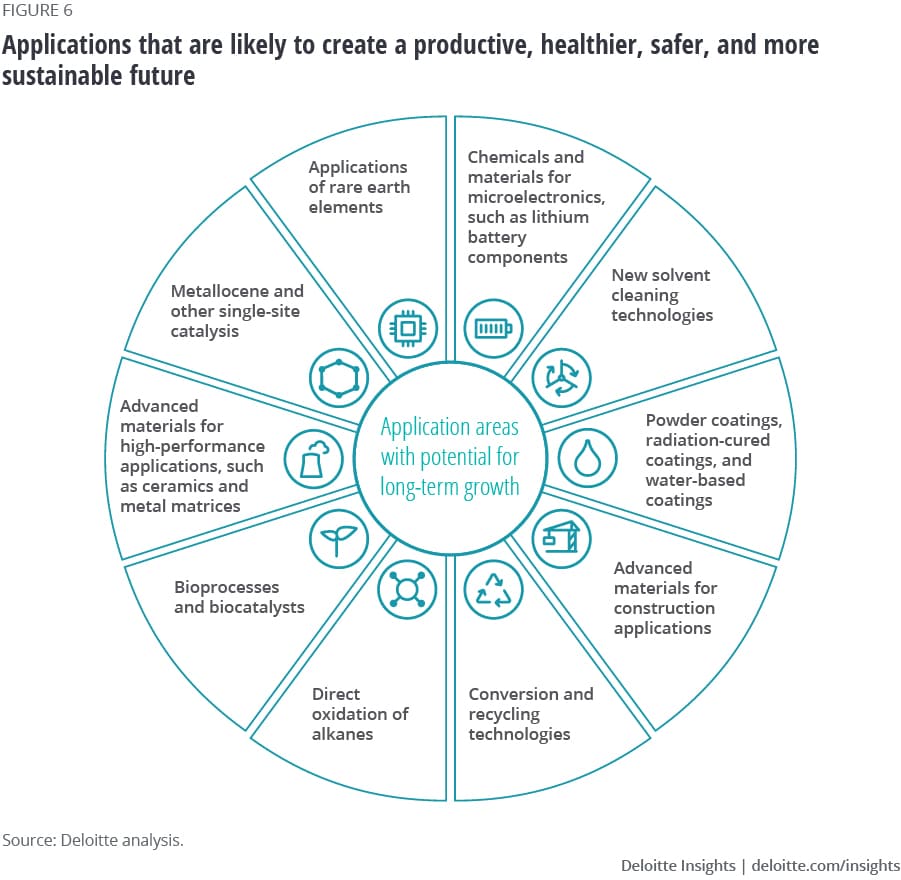
Changing feedstock dynamics
Cost advantage to continue despite volatility in energy prices
What is the petrochemical feedstock advantage? Owing to the relative abundance of light oil and natural gas in the United States, natural gas liquids (NGLs), specifically ethane, account for about 90% of US petrochemical production.12 In contrast, 70% of European and Asian petrochemical production is based on naphtha, a petroleum-based feedstock.13 As US petrochemical producers use ethane and other NGL feedstocks coproduced with natural gas as their primary feedstock, ethane’s price is correlated with natural gas prices. There are only two uses for ethane—one as feedstock in the petrochemical production process and the other as fuel. And as petrochemical companies in Europe and Asia use the refinery byproduct naphtha (a petroleum product) as their primary feedstock, their price is closely tied to oil.
Because oil is traded on the world market, all countries are subject to roughly the same price, varying based on quality and access to infrastructure. Natural gas markets, however, are regional. In other words, the natural gas price in North America affects primarily North American producers. So, US petrochemicals enjoy a competitive advantage (figure 7) when natural gas prices are low relative to oil prices. In addition to upstream supply growth, prices for petrochemical feedstock tend to be significantly influenced by refinery operations, indicating an increasingly interconnected global energy value chain. Moreover, competition between feedstocks also affects competitiveness. For instance, US steam-cracking assets are seeing ethane compete with liquefied petroleum gas (LPG) or propane in domestic production facilities. Similarly, in Asia and Europe, naphtha competes with LPG in regional ethylene plants.
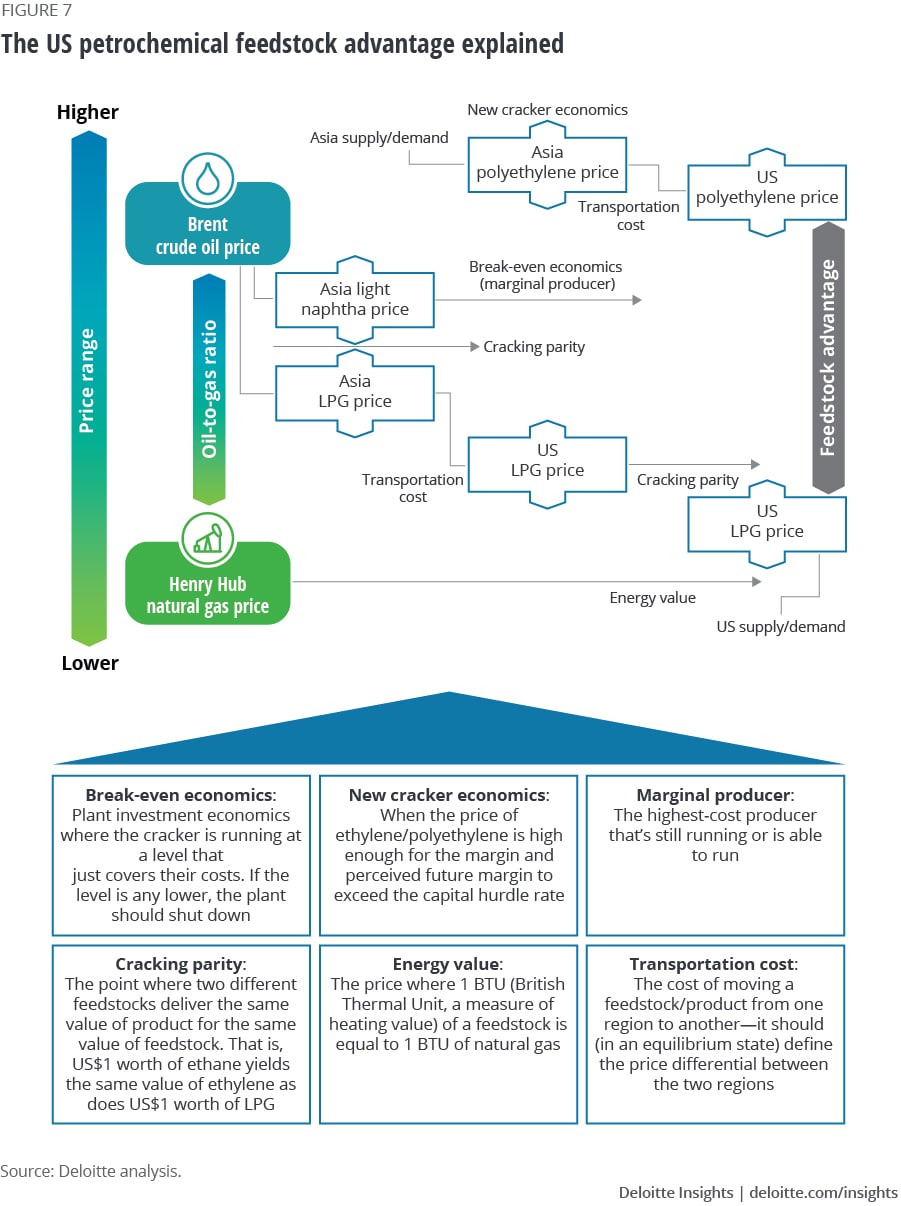
Is the United States still advantaged? The relative price of oil to natural gas is a proxy measure to assess US petrochemcial companies’ competitiveness as the wider the spread, the more advantageous ethane should be. Lower oil prices make heavier feedstocks, such as naphtha and LPG, more competitive relative to lighter feedstocks such as ethane. As a rule of thumb, when the oil-to-natural-gas price ratio is above 7, US petrochemicals are relatively advantaged, and when it is below 7, US petrochemicals are less advantaged (figure 8).14 For example, this ratio averaged 25.2 in July 2020, compared to an average of 31.3 in January 2020.15 Volatility in oil and natural gas prices and ethane production shut-ins due to COVID-19 were key drivers for this decline.
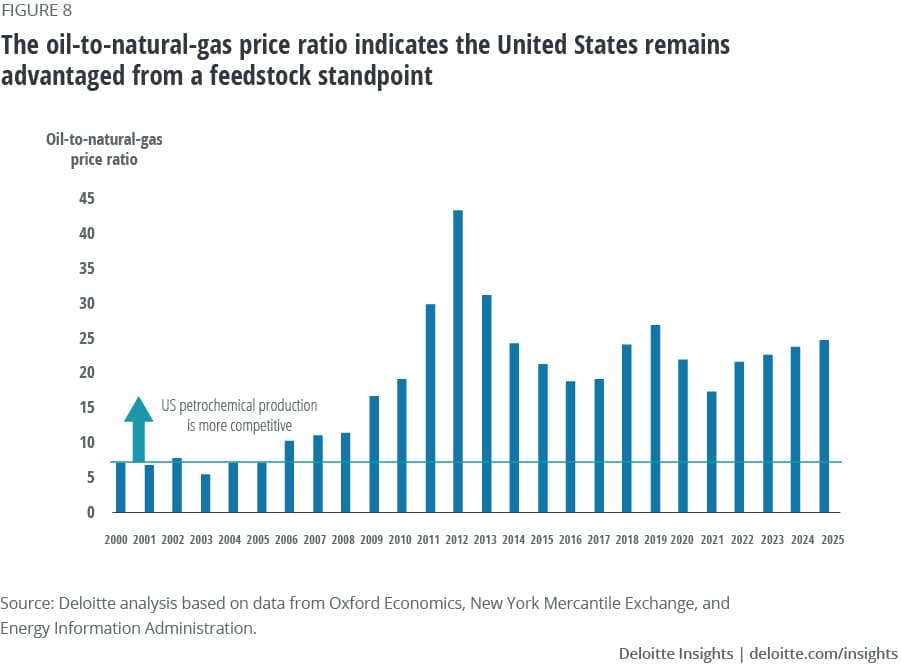
What happened in 2020? Demand for both oil and natural gas declined globally in H1 2020 as COVID-19 impacted economic activity, primarily commercial and industrial activity, which remain major sources of oil and natural gas consumption.16 The decline in demand combined with inelastic short-term supply drove global oil and natural gas prices to record lows in H1 2020.17 While oil prices recovered some of the lost ground, natural gas prices remain low due to persistent oversupply and slow demand recovery. The drop in oil prices flattened the global ethylene cost curve, leading to reduced cost advantage for ethane crackers relative to naphtha crackers.
Will the US feedstock advantage last? The US feedstock advantage is driven by having abundant, low-cost ethane feedstock to produce ethylene and polyethylene (PE), competing against manufacturers of ethylene/PE who have access only to high-cost naphtha as feedstock. Global oil prices are expected to continue to recover as the pandemic-driven lockdown measures are eased, demand recovers, and a large share of crude oil production continues to be managed by the Organization of the Petroleum Exporting Countries (OPEC). But US Henry Hub prices are forecast to remain under US$3 per million Btu on average over the next two to three years.18 This can help maintain production economics in favor of ethane-based crackers. Therefore, the low natural gas prices will likely continue to provide a feedstock advantage for US petrochemicals and keep them competitive versus their European and Asian rivals over the next decade. However, the feedstock advantage could be threatened by an unexpected and sustained surge in natural gas prices due to factors such as supply-demand imbalance.
Even if the global ethylene cash cost curve flattens for a brief period, ethane will likely remain the most favored cracker feedstock due to two key factors. First, ethane production costs are not sensitive to oil price levels, while naphtha-based producers need a lower oil price to remain competitive. And second, ethane-based production requires lower levels of feedstock input compared with naphtha—a little over one ton of ethane is required to produce a ton of ethylene, while more than three tons of naphtha is needed to produce a ton of ethylene. In other words, ethane-based production is more efficient and requires less feedstock for the same level of output. And in case ethane prices rise and naphtha gains the feedstock cost advantage, crackers with flexibility to switch between the two as well as LPG could ease run-ups on ethane.
What could erode the US feedstock advantage? This feedstock advantage will likely continue as long as (a) crude prices remain high relative to gas prices and (b) the US overbuilds ethane-cracking capacity. The advantage could be threatened by an unexpected and sustained surge in natural gas prices due to factors such as supply-demand imbalance and a significant and persistent decline in oil prices owing to reasons such as demand erosion. For example, if US Henry Hub prices rise to US$5 per million Btu and if crude oil prices remain below US$35 per barrel, the US feedstock cost advantage could erode (figure 9) as the oil-to-natural-gas price ratio would be below 7. Similarly, in another scenario, if US Henry Hub prices remain at US$2 per million Btu but if crude oil prices decline below US$14 per barrel, the US petrochemical companies could lose feedstock cost advantage as the oil-to-natural-gas price ratio would remain below 7.
Moreover, if the supply of ethane exceeds demand, then the price could drop until demand picks up or the price falls so low that the value is at par with natural gas. In such a case, ethane could be rejected, i.e., it may not be recovered from the natural gas stream at the gas processing unit and would be used as fuel. Once the price rises above fuel parity, recovery of ethane could resume.
Overcapacity
Pressure from both supply and demand fronts
The US petrochemical industry has entered a period of overcapacity relative to demand, which is adversely affecting the operating rates of many base petrochemicals (figure 9).19 This has its primary roots in the previous investment cycle—from 2014 to 2019.20 The industry became globally competitive in the early 2010s, mainly due to the shale gas revolution. Many companies commissioned new capacity along the US Gulf Coast to export to growing international markets as low-cost producers of ethylene and PE. The availability of cheap domestic shale gas led to the construction of 340 petrochemical projects totaling US$204 billion in investments in the United States since 2010.21 New ethylene production capacity grew by 35% from 2014 to 2019.22 But this new capacity is more than the market can absorb, driving down ethylene prices that fell from US$739 per metric ton in 2017 to US$347 in July 2020.23 Also, with the commercialization of COTC technologies, oversupply may be exacerbated in 2020 and beyond, especially for heavier base chemicals.24
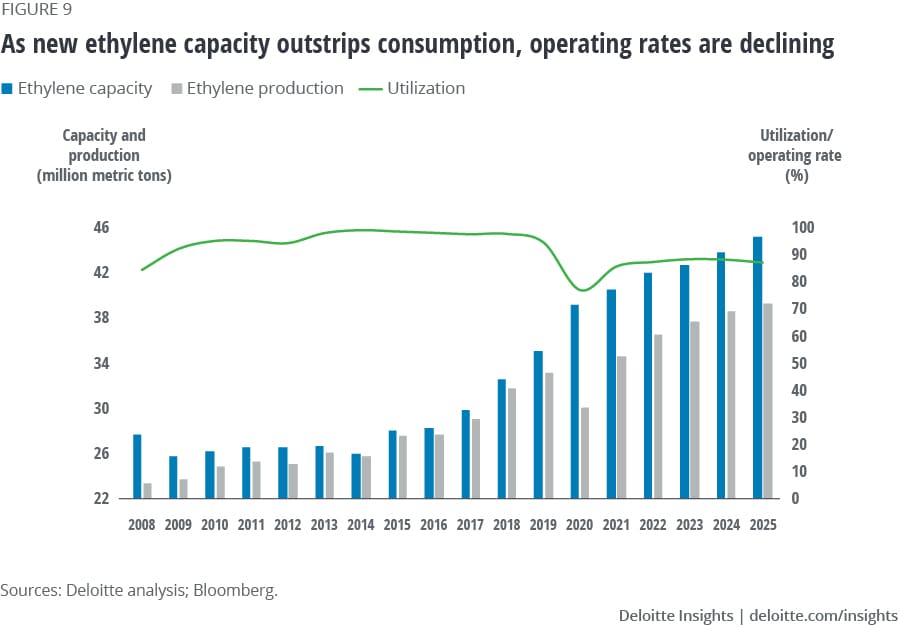
With COVID-19, global demand further eroded, exacerbating the overcapacity situation and challenging exports. An increase in ethylene production capacity in the United States (figure 10) and weakness in ethylene’s downstream markets such as PE paint a large oversupply picture, which is weighing on spot prices that are expected to remain in the downturn until the middle of this decade. Moreover, domestic players in large emerging markets such as China and India are primarily focused on their home markets and usually have protected local positions, including tariff protection. Therefore, a critical consideration for US companies continues to be competing well in international markets, mainly with state-owned enterprises (SOEs), which are likely to become more influential in the future. For instance, the Saudi government is pushing for a more significant presence in downstream industries, especially in petrochemicals.25 This involves taking national oil and energy companies public, merging companies to realize synergies across businesses, investing in growth markets, and capitalizing on state-of-the-art manufacturing technologies that enable higher chemical yields.26
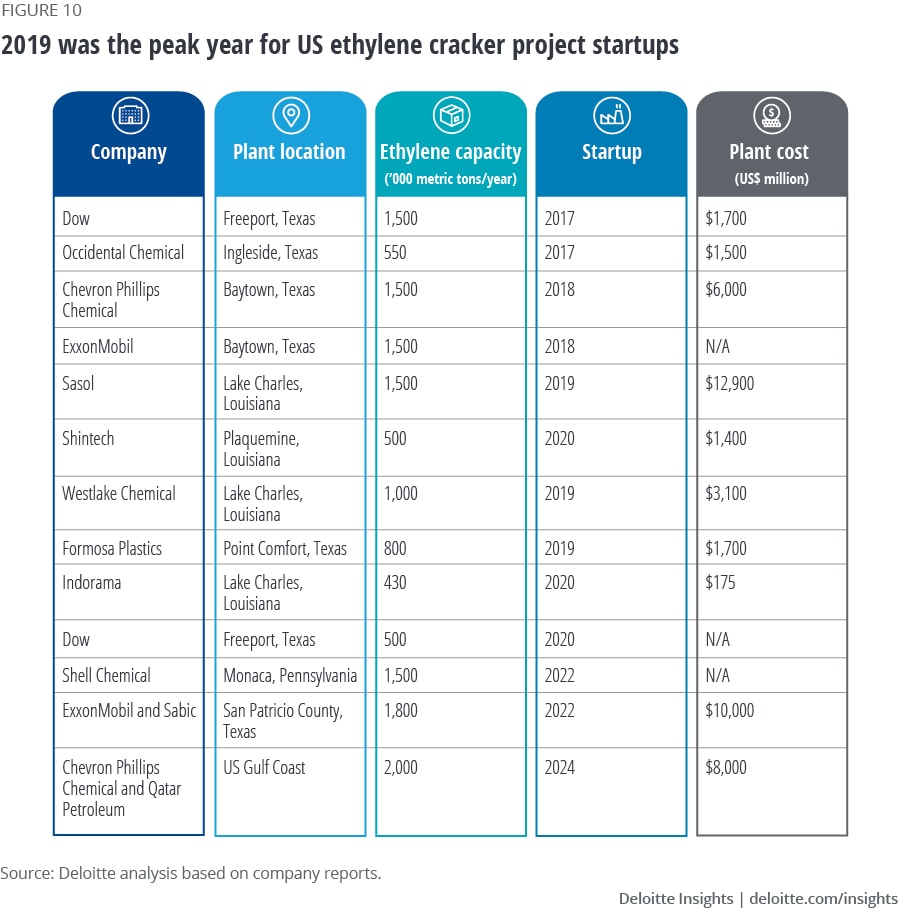
The industry can respond to oversupply and the resulting margin pressure by directing efforts toward driving higher process efficiencies and enhancing cost savings across the value chain with the help of digital technologies. Increasing downstream synergies can also be explored with integrated oil and gas and commodity chemical companies venturing further into the specialty chemicals space through bolt-on acquisitions to weather the downturn.
In the near term, production and capital investments will be cut and construction of new petrochemical plants will be deferred. Also, some capacity-focused capital expenditure projects may even get scrapped as companies grapple to maintain margins, cut costs, and rationalize capital allocation. In the long term, US executives are expected to remain cautious about building bigger ethylene complexes. As the construction of new plants winds down, it should help the market become better balanced, driving recovery in prices.
International trade barriers
Geopolitical rivalry between the United States and China remains a headwind
US petrochemical exports are expected to decline sharply during the period 2020–23 as import demand in partner economies such as Canada, Mexico, and Europe has collapsed and will likely remain weak (figure 11).27 The recovery could be mixed as it is vulnerable to downside risks with the industrial sector in international markets having fallen steeply.28 Moreover, weakness in US industrial activity and consumer spending could result in decreased US petrochemical imports as the sudden and severe economic recession is expected to have a lasting influence on business investments and household spending.29 Specifically, trade in petrochemicals used as inputs into end markets such as the auto manufacturing supply chain could remain sharply lower, and full recovery to pre–COVID-19 levels is unlikely before 2023.30
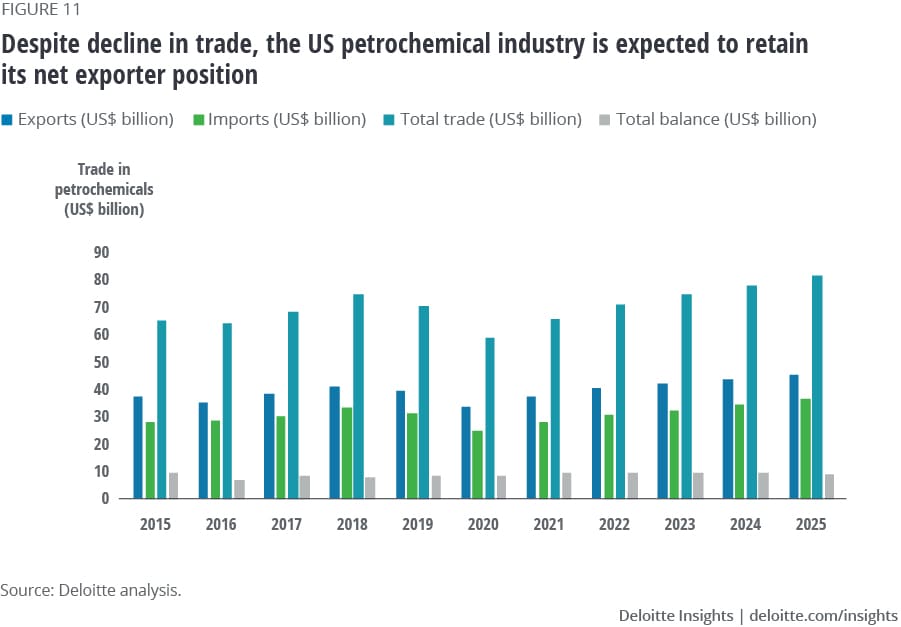
The ongoing trade dispute between the United States and China will likely continue to impose an element of unpredictability in demand. Increased tariffs on US petrochemical imports into China have the potential to lessen the low-cost advantage enjoyed by US producers. Moreover, this raises access barriers in the Chinese market where US plastics are in high demand. For instance, large-scale expansions in the US PE and ethylene glycols (EG) industries are heavily targeted at exports, primarily to China, due to its dominance in many manufacturing industries.31 During the next decade, Chinese PE demand could increase up to 20 million tons and total consumption for PE in China could be about 530 million tons, driving the global petrochemical demand (figure 12).32 Similarly, the Chinese EG demand could grow by 12 million tons and overall consumption of EG could be around 250 million tons in China.33 This underlines that US companies are to some extent tied to China’s economic fortunes.

Tariffs on US-Chinese petrochemicals trade and downstream products such as high-density polyethylene (HDPE) and linear low-density polyethylene (LLDPE) remained in place even after the Phase 1 deal reached early in 2020.34 US producers have demonstrated agility in shifting some PE exports away from China to avoid tariffs. US chemical exports to China fell 14.4% in 2019 YoY.35 But China is by far the biggest net PE and EG import market globally as it will likely account for between 55% and 60% of all global net PE imports and about 80% of all global EG imports over the next decade.36 Due to the higher volumes, exports to China result in better margins because of economies of scale with reduced logistics costs. Also, dealing with smaller markets to compensate for the loss of volume in exports to China results in higher trader and distributor fees. A sustained shift of US export flows away from China could lead to lower netback per ton, impacting profitability.
There is the additional threat of China readjusting its chemical supply chains to reduce its heavy dependency on US plastic imports. This may threaten the demand for US products as China remains the biggest market for petrochemicals, for which it doesn’t have enough domestic capacities. So, it will be important for companies—especially those with the United States as their base manufacturing location—to be prudent in planning new capacity expansions.
Sustainability and the circular economy
A potential game changer in the long run
There is heightened awareness of and consumer support for reducing carbon emissions. This change in public perception and preference toward sustainable consumption, along with a policy push, could necessitate petrochemical companies to develop new sustainable products and business models. Governments worldwide will likely continue restricting the use of single-use plastics such as plastic bags and straws. In response, large consumer product manufacturers are expected to reduce the amount of polymer used and increase recycled content in packaging. Therefore, companies have an opportunity to address all aspects of the circular economy over a product’s life cycle—from production and utilization to disposal. For instance, Shell intends to cut the carbon intensity of the petrochemical products it sells by around 30% by 2035 and by 65% by 2050.37 This offers companies significant growth potential in two areas—they can support customers in reaching their sustainability targets and extend their core business with new circular business models. Realizing this vision can lead to substantial economic benefits, including significant net material savings (figure 13). The full value of the circular opportunities in the packaging industry alone is estimated at US$270 billion per year in materials savings.38 The industry has begun taking steps to move toward the circular economy. A case in point is the Alliance to End Plastic Waste, a consortium of several international companies that aims at joint production of bio-based methanol and ethanol from municipal waste, including those that cannot be mechanically recycled into high-quality chemicals through synthesis gas.39
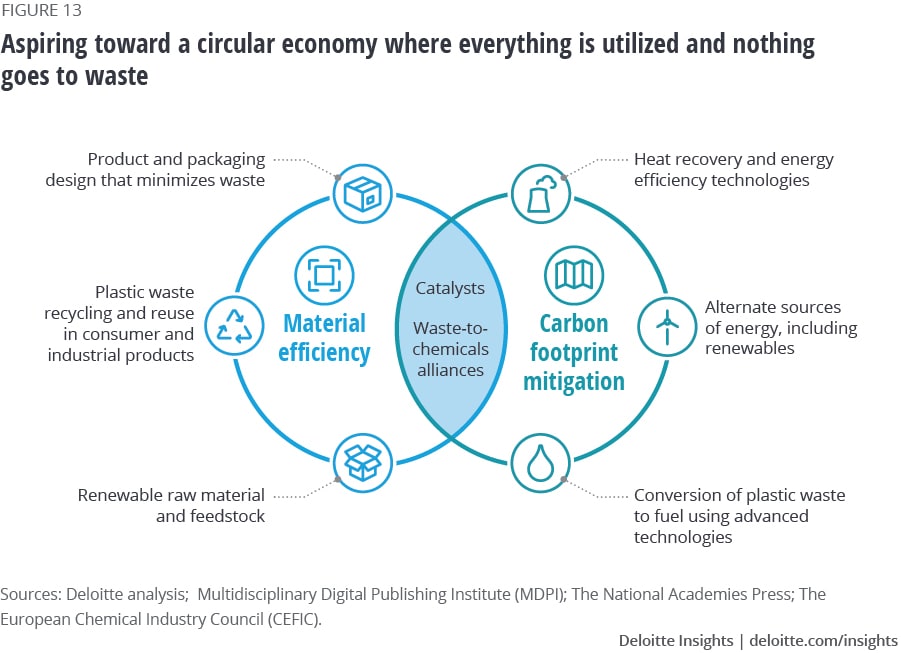
Four areas petrochemical companies can focus on related to achieving a circular economy are:
Product design: Through a coordinated effort across the value chain, petrochemical companies can make great strides in the development of polymers that allow processors to consume less material while maintaining the quality of their products, whether it be strength or durability. They can work with end-market customers to design more sustainable products. An example is carbon fiber–reinforced composites that can replace steel and aluminum in vehicle components and reduce their weight by a half, which leads to lower fuel consumption and CO2 emissions.
Renewable manufacturing: An example of renewable and resource-efficient chemical manufacturing is Covestro. Since 2016, Covestro has replaced about 20% of the crude oil used in its PUR manufacturing with CO2, which is generated by other production processes.40 In another instance, Air Products announced a US$5 billion green hydrogen project in the Middle East, with the hydrogen being sourced via electrolysis, a technique that uses direct electric current to drive an otherwise nonspontaneous chemical reaction and powered entirely by renewable electricity.41
Recycling: There is a US$120 billion market opportunity in the United States and Canada for petrochemicals that could be developed by recovering waste plastics.42 Using closed-loop recycling, a polymer can be chemically reduced to its original monomer form so that it can then be processed and remade into new plastic materials. This can help overcome the limits of mechanical recycling, which takes the plastic and reforms it into a usable pellet. Some companies have begun adopting closed-loop systems with minimum waste, constant material recycling, and reuse. LyondellBasell is developing its own proprietary chemical recycling technology and expanding the types of mechanically recycled resin it offers. The company plans to produce and market two million metric tons of recycled and renewable-based polymers per year by 2030.43
Waste disposal: Companies can address the plastics waste challenge by using sustainable disposal mechanisms such as pyrolysis, which helps turn nonrecycled plastics from municipal solid waste into synthetic crude oil; this, in turn, can be refined into gasoline, diesel, or heating oil. Pyrolysis can help convert nonrecycled plastics into ultra-low sulfur diesel fuel (ULSD), reduce greenhouse-gas (GHG) emissions by 14%, and save up to 96% in energy use compared to conventional crude oil.44
Building a more resilient petrochemical company
Petrochemical companies can use the major industry shifts as opportunities and enhance their competitive edge by focusing on areas such as portfolio restructuring, M&A, digitalization, sustainability, innovation, and talent strategy to build the next-gen workforce. Industry executives can begin by making choices to be in markets and regions where they can derive most value; leverage the existing competitive advantage to serve the home market well; and build capabilities to support global demand through approaches such as JVs or building assets in growth regions. Key considerations include the right timing for these investments and whether they want to do it alone or work with a partner. There is no single road map to achieve long-lasting success, and companies should consider adopting a multipronged approach (figure 14).
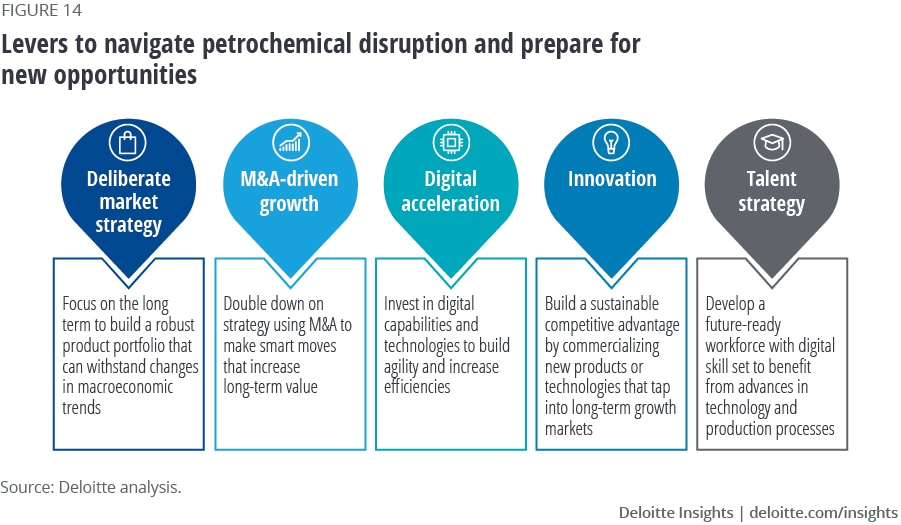
Deliberate market strategy
Petrochemical companies can build lasting resilience through macroeconomic analysis of long-term trends and implications and then make an informed and deliberate strategic choice about which markets they focus on. COVID-19 has proven that focusing on relatively short-to-medium-term supply-demand imbalances or advantages can be a questionable strategy. One of the critical aspects of dealing with disruption is understanding customer behaviors that are temporary versus permanent as recovery will likely be uneven across end markets and geographies. Companies can grow earnings in different operating environments if they build a product portfolio that can withstand changes in macroeconomic trends. For instance, Linde continues to invest in the electronics business by targeting growth opportunities in the semiconductor, wafers, silicon, and photovoltaics industries, which are expected to have long-term demand due to the growing need for technology infrastructure.45 Companies can also address uncertainty by revisiting their product portfolio and conducting robust scenario planning by including the unknowns.
M&A-driven growth
Companies with strong financial discipline can potentially leverage the current disruption to double down on crucial elements of their strategy using M&A. As companies focus on divestments of noncore or underperforming assets to raise cash during the economic downturn, industry players that are well-prepared and have robust balance sheets can look at making smart acquisitions that create increased shareholder value. Specifically, companies can focus on re-assessing their strategic priorities, including strengths and weaknesses in their business models; the need for vertical and horizontal integration; and increased opportunities for growth in emerging markets. Take the example of Shell. In a move to expand its foothold in the growing Indian market where local refiners are investing billions of dollars to boost their petrochemical capacities, Shell announced it would buy a 50% stake in India-based Nayara Energy’s US$9 billion petrochemical project.46 In another instance, INEOS announced its intention to acquire BP’s global Aromatics and Acetyls business for a consideration of US$5 billion. The deal will likely expand INEOS’s position in global petrochemicals and provide scope for expansion and integration with its existing business.47
Digital acceleration
The industry can become more agile, innovative, and efficient by accelerating its digitalization efforts. Many new digital capabilities are already in place or underway, which could help build a more intimate relationship with customers and end-markets. These include:
- Investing in digital tools such as sales management apps to connect with customers virtually and help improve sales force efficiency through effective pipeline management and lead tracking.
- Building AI-based real-time demand sensing models to leverage market forecasts and shift application portfolio.
- Using advanced analytics to generate actionable and deep insights on first-, second-, and third-party data to inform operational decisions.
- Deploying cloud-based technologies to power-connected solutions.
Building an ability to identify shifts in the industry landscape through digital technologies can help companies respond quickly and deliver better customer experience. For instance, Dow Chemical’s Water Solutions business unit uses a mobile ordering and tracing system where orders can be placed and tracked. Customers can also request a brochure or contact sales and technical support using this portal to get the most up-to-date product information.48
Moreover, digital technologies, including the IoT, could help petrochemical manufacturers to automate key chemical engineering processes, integrate machines, monitor performance, and predict equipment failure. However, optimizing performance is not just restricted to the application of digital technologies. New digital technologies such as blockchain and predictive analytics can be integrated with existing IoT infrastructure to enable track-and-trace capabilities that can lead to fine-tuning of production yields in response to fluctuating demand of end products and prices of feedstocks. Also, new process technologies such as COTC have already been deployed in some refinery-scale petrochemical plants. The effective integration of digital with physical assets becomes even more critical for these upcoming, state-of-the-art plants.
Innovation
Innovation is important for building a sustainable competitive advantage during disruptive times. Even as companies focus on reducing costs versus commercializing new products or technologies to tap into growth markets, they should plan for creating long-term value by looking at the bigger picture. With a host of cost-effective digital R&D tools at their disposal, they can acquire, amalgamate, and nurture the best combination of systems, products, and processes—even during tough times.
But petrochemical companies’ age-old approach to innovation and the status quo might no longer be an option. This is because a staggering amount of change has occurred in the industry with the rise of digital technologies and open digital platforms. Until now, the process of discovering and developing new chemicals has remained mostly unchanged and primarily laboratory based. This made it difficult to predict the behaviors of materials under new conditions and required many lab experiments, which were frequently expensive, unproductive, and time-consuming. There was often a disconnect between the accelerating pace of change in the marketplace and the innovation process’s slowness. New startups that lie at the intersection of petrochemical engineering and computer science are envisioning open digital platforms to address this challenge. These platforms can accumulate vast amounts of knowledge from varied sources into a single, reliable, searchable format and leverage machine learning algorithms to quickly and efficiently develop new innovations.
Companies could consider adopting innovative approaches that suit their business models and organizational cultures. Also, by focusing on collaboration and partnering with the ecosystem, they can reduce overall R&D costs and time to bring new products and applications to the market. For instance, Innospec is developing new proprietary technologies intended to become a benchmark for fuel performance by equipping R&D centers with advanced synthesis equipment; supporting scientists and technicians with analytical tools and technologies for testing fuel additives and oilfield chemicals; and collaborating with a number of leading universities around the world.49
Talent strategy
While automation and the use of advanced digital technologies are driving productivity, they’re also leading to change in the workforce composition, increasing the need for a workforce with more advanced petroleum and chemical engineering, math, data science, and digital skills than before. But with advances in technology and production processes and increase in remote work, many companies are facing challenges in attracting and retaining skilled workers. Also, an aging workforce is leading to a skills gap. This impacts the industry on multiple fronts. Implementing new manufacturing technologies, developing new products, and improving customer engagement are all adversely affected. Developing a future-ready workforce requires focusing on encouraging a culture of innovation. Moreover, building a digital skill set requires companies to consider multiple strategies. These include:
- Providing continuous training to upskill the workforce
- Investing in startups to get access to new technology and talent
- Leveraging acquisitions to gain the desired talent
- Tapping the intrinsic knowledge and best practices from senior and retiring team members
- Partnering with educational institutions for Industry 4.0 skills
- Adding talent from companies that are in a weaker financial position
For example, SABIC Academy offers online competency-based learning across 12 career lines with a wide range of accessible courses to all its employees, including advanced programs in disciplines such as manufacturing, supply chain, sales, and marketing.50
Riding the next wave of growth
As the US petrochemical industry moves into the future, the pace of accelerated change is only expected to quicken. Changing paradigms due to evolving economic, social, environmental, and innovation expectations could transform the industry landscape. To thrive in the future, companies should consider implementing a series of targeted, strategic initiatives across major functional areas such as R&D, talent, and technology. A focus on the short term could mean that companies end up neglecting long-term opportunities, including investing in innovation, emerging applications, and adopting new business models that generate sustained growth. The time seems ripe for petrochemical companies to disrupt or be disrupted.